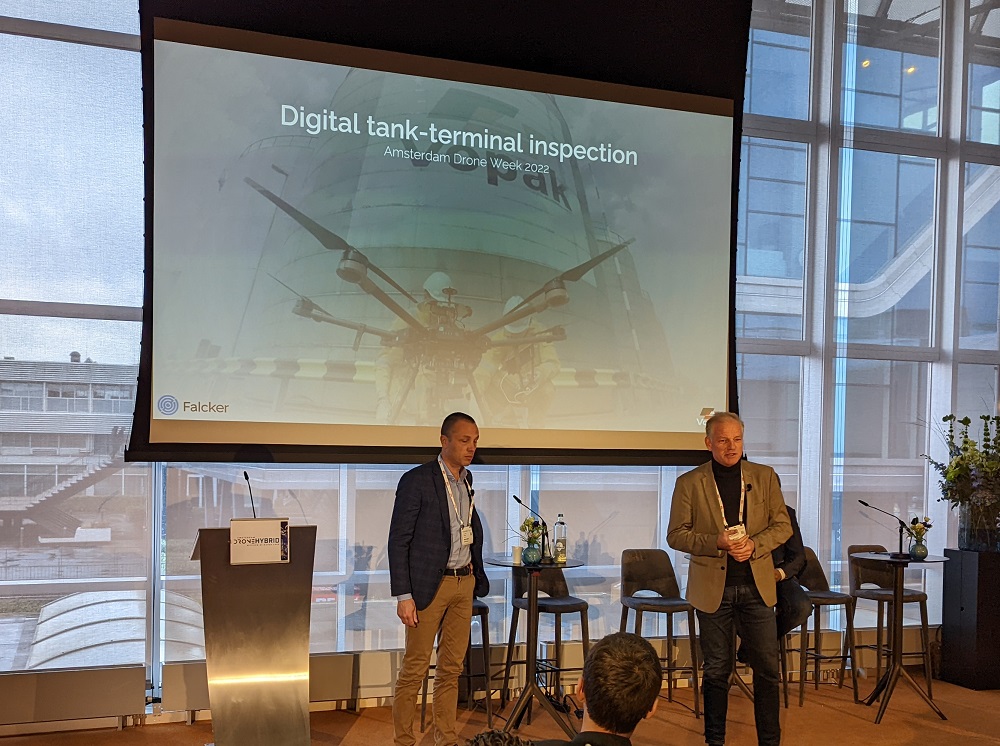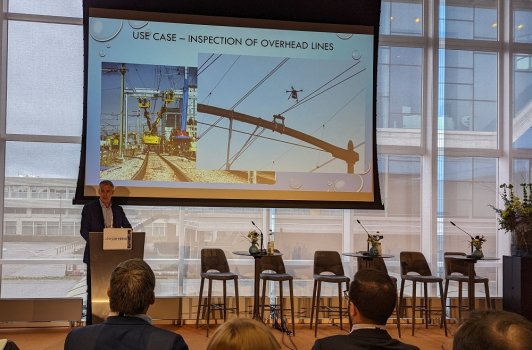K
Kathleen Martin
Guest
Inspecting pieces of infrastructure, means of transportation like rails and at airports with drones can create efficiencies in multiple ways. It’s easy enough to call out these efficiencies as being faster, cheaper or safer than traditional approaches, but what does it mean to turn thousands of photos into actionable information? How can these efficiencies be measured in terms of an ROI? Jarno de Jong from GEO INFRA and Jonas Stjernberg from Robots.expert moderated two panels during Amsterdam Drone Week to outline these specifics and much more.
Tsjerk Koolstra from Dutch Drone Company kicked off the first session by details how his company has used drones for onshore, offshore and confined space projects. He shared details about the John Frost Bridge inspection which saw DDC use several types of drones to inspect all areas of the bridge, including underneath the deck and pillars. Using a drone kept traffic from being disrupted and with the data collected by the drone they were able to create a digital twin that can now be remotely accessed. With it, people can avoid physically being at the location, saving money and reducing the risk of people working on scaffolds.
With tanks located all over the world, Vopak stores and handles products ranging from chemicals, oil, gases and LNG to biofuels and vegoils. Bart van der Meer, Innovation Engagement Leader at Vopak, has pioneered the use of drones as a means to improve their inspections, but the challenges with doing so are as much about people as they are process. What does it mean to shift people’s focus? How can advocates enable belief in new tech with old thinking? It’s a challenge that they’re working through with partner Falcker, and Falcker CIO Duco Boer joined him on the stage to discuss what sorting through these challenges has meant from a technology perspective.

That technology challenge is about answering questions related to how to assess 1,000 photos per tank and what it means to use drones or traditional sensors to capture the info needed for an inspection. Once these decisions are made, the team can use AI-based funneling methods to closely review photos that identify corrosion and damage. That keeps people from having to review every single photo. These differences are defining the ROI of the technology in the short term,but Vopak team is working to switch to BVLOS operations using Percepto AIM to enable value in the long term. They see the technology as an autonomous platform to capture data which is switch they’re pushing for, as autonomous solutions will majorly impact their costs.
Dennis Jansen from Antea Group highlighted what it means to create efficiencies with drones for bridge inspection but highlighted how context drives when and how the technology is applied. Why use a drone for a given task? Jansen answered that question with a look at his team’s work on the Muiderspoorbrug that spans the Amsterdam-Rhine Canal and is part of the Amsterdam-Zutphen railway line. Over 11,000 photos were taken in a single drone flight which allowed the team to build a digital twin.
Continue reading: https://www.commercialuavnews.com/infrastructure/the-roi-of-drone-technology-in-infrastructure-transportation-and-at-airports
Tsjerk Koolstra from Dutch Drone Company kicked off the first session by details how his company has used drones for onshore, offshore and confined space projects. He shared details about the John Frost Bridge inspection which saw DDC use several types of drones to inspect all areas of the bridge, including underneath the deck and pillars. Using a drone kept traffic from being disrupted and with the data collected by the drone they were able to create a digital twin that can now be remotely accessed. With it, people can avoid physically being at the location, saving money and reducing the risk of people working on scaffolds.
With tanks located all over the world, Vopak stores and handles products ranging from chemicals, oil, gases and LNG to biofuels and vegoils. Bart van der Meer, Innovation Engagement Leader at Vopak, has pioneered the use of drones as a means to improve their inspections, but the challenges with doing so are as much about people as they are process. What does it mean to shift people’s focus? How can advocates enable belief in new tech with old thinking? It’s a challenge that they’re working through with partner Falcker, and Falcker CIO Duco Boer joined him on the stage to discuss what sorting through these challenges has meant from a technology perspective.

That technology challenge is about answering questions related to how to assess 1,000 photos per tank and what it means to use drones or traditional sensors to capture the info needed for an inspection. Once these decisions are made, the team can use AI-based funneling methods to closely review photos that identify corrosion and damage. That keeps people from having to review every single photo. These differences are defining the ROI of the technology in the short term,but Vopak team is working to switch to BVLOS operations using Percepto AIM to enable value in the long term. They see the technology as an autonomous platform to capture data which is switch they’re pushing for, as autonomous solutions will majorly impact their costs.
Dennis Jansen from Antea Group highlighted what it means to create efficiencies with drones for bridge inspection but highlighted how context drives when and how the technology is applied. Why use a drone for a given task? Jansen answered that question with a look at his team’s work on the Muiderspoorbrug that spans the Amsterdam-Rhine Canal and is part of the Amsterdam-Zutphen railway line. Over 11,000 photos were taken in a single drone flight which allowed the team to build a digital twin.
Continue reading: https://www.commercialuavnews.com/infrastructure/the-roi-of-drone-technology-in-infrastructure-transportation-and-at-airports

